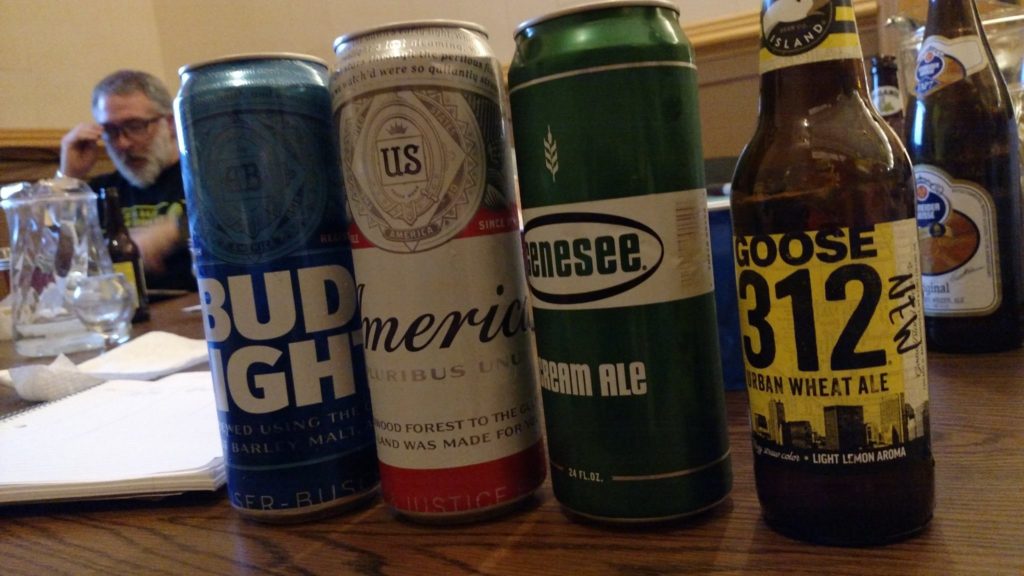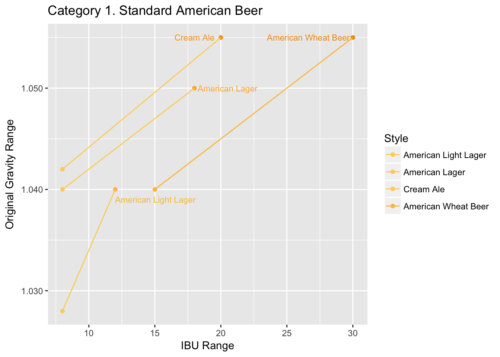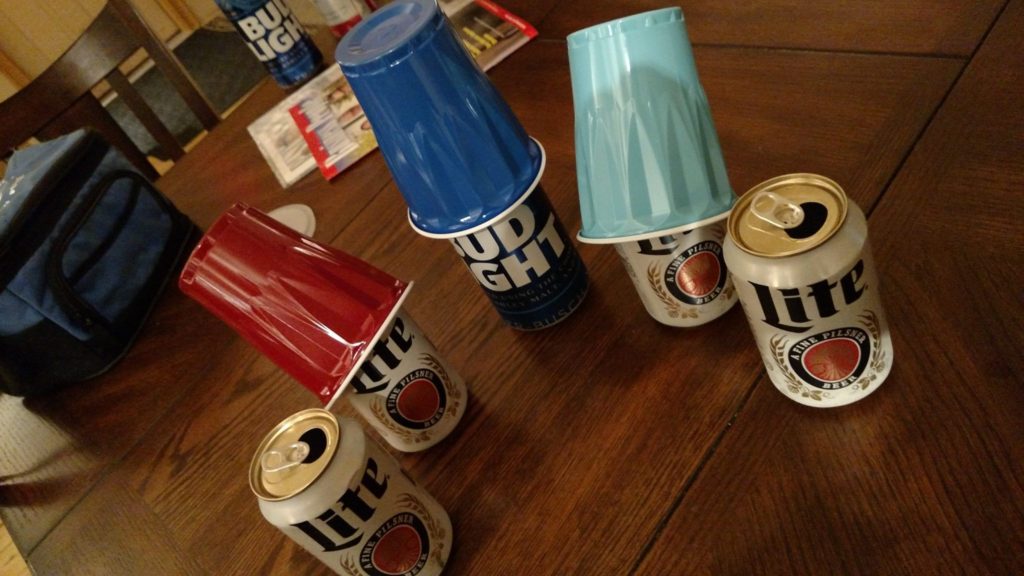BJCP Study Group: Category 1
¶ by Rob FrieselFollowing our successful introductory session, our BJCP study group re-convened two weeks later 1 to cover Category 1: Standard American Beer.
After a quick round of group business, we launched right into the structured evaluations.
Category 1: Standard American Beer
Category 1 beers are the “everyday American beers that have a wide public appeal”; in other words: the mass-market beers — the cheap, flavorless lagers. That said, Category 1 also includes ales, but even these have “tame” descriptions such that they can be “crossover beers”.
| 1A. American Light Lager | 1B. American Lager | 1C. Cream Ale | 1D. American Wheat Beer |
|---|---|---|---|
| 8 – 12 IBU | 8 – 18 IBU | 8 – 20 IBU | 15 – 30 IBU |
| 1.028 – 1.040 O.G. | 1.040 – 1.050 O.G. | 1.042 – 1.055 O.G. | 1.040 – 1.055 O.G. |
| 0.998 – 1.008 F.G. | 1.004 – 1.010 F.G. | 1.006 – 1.012 F.G. | 1.008 – 1.013 F.G. |
| 2.8 – 4.2% ABV | 4.2 – 5.3% ABV | 4.2 – 5.6% ABV | 4.0 – 5.5% ABV |
- 1A. American Light Lager. Bud Light was our subject for the 1A structured tasting. The group made plenty of jokes (“Is this even beer?”) and semi-nostalgic asides as we worked through our sensory impressions. One point we all agreed on was in recognizing the challenge of comparing the beer to-style and leaving your personal preferences out of the equation. (And that this was doubly challenging when “to-style” also meant that the beer was effectively flavorless.)
- 1D. American Wheat Beer. We evaluated Goose Island’s 312 as our wheat beer for the session. An interesting aside here was in remarking on the challenges of evaluating a beer when the style leaves a lot of room for brewer interpretation. I suspect that this is a problem we will discuss a few more times before our sessions wrap up.
- 1B. American Lager. Budweiser. Again with the important lesson of separating your tastes from the fact that you’re attempting to judge to-style. Also an object lesson in differentiating two styles (i.e., 1A vs. 1B) that can seem very similar to one another.
- A homebrew example of 1B. Our coordinator for the night had a couple bottles of a lager beer from a recent competition. It was interesting to perform the sensory evaluation on a homebrewed example of an American Lager immediately after a commercial example. For all the perceived flaws that we found with the Budweiser, the contrast with the homebrewed example was stark. It was also a firm reminder that, despite personal preferences, these beers can be quite difficult to brew successfully. We all identified multiple faults and most of us went on to dump our samples.
- Another homebrewed 1B. Hot on the heels of the previous homebrewed example, we got this curveball: apparently this particular example had been a ribbon-winner in the American Lager category, however the bottle had also been re-capped. It was a good object lesson in oxidation effects.
- 1C. Cream Ale. Genessee Cream Ale. We did our structured evaluations. We discussed the style. On my own tasting sheet, I had scribbled an aside comparing a macro example like Genessee to craft examples like our local American Dream.
- Triangle Test! Our coordinator for the Category 1 session set us up with a challenge after we’d done our “standard” style reviews for the category. He placed the three different color cups in front of each of us and asked: “Which is the odd beer out? And which style is it?” We spent several minutes sniffing and tasting, really putting our sensory skills to the test. As it was our first triangle test, I think it’s safe to say that it was more challenging than most of us expected. A couple in the group got the odd-beer-out correct (myself included) but I believe only one correctly guessed the style (1A. American Light Lager). Anyway… I guess now I can boast that I could tell apart a Bud Light from a Miller Light.
- Age differences? After the triangle test, we did a side-by-side between two batches of Goose Island 312: one bottled in January 2017 vs. one bottled in March 2017. For what it’s worth, I couldn’t really tell them apart; other members of the group claimed to perceive differences (e.g., a dull “cardboard-like” flavor in the older example) but I remain skeptical. This would be a good one to repeat as a blind triangle test.
- Bonus round. As we wrapped up the (at this point) running-late study session for the night, a few more bottles were pulled out for quick tastes and comparison. We ran through a Samuel Smith Organic Lager, Aventinus TAP7, Franziskaner Weissbier, and a Zero Gravity Green State Lager. We skipped the structured tasting exercise and just focused on overall impressions.
Takeaways
Like last time, I took a few notes that looked broadly across all of the evening’s structured evaluations. What were the themes that emerged? What skill development did I need to focus on? What was my homework?
- Consider temperature changes. How do the aromas and flavors change as a beer warms up? How much does the sample warm over the 5-10 minutes of the tasting?
- Looking for off-flavors. It wasn’t so much that I should expect them, but I found that I needed to be more open to their presence — perhaps even to stop being so forgiving. That said, I would need to get myself more familiar with “the symptoms” and how each of those off-flavors present.
- Controlling for and coping with off-flavors. Speaking of off-flavor training, if I’m going to become more familiar with identifying them, then I’d better be prepared to speak to what causes them and then either how to prevent it or else cope with it. Providing the brewer feedback on the scoresheet is critical. So if I say that I’m detecting DMS then I better be prepared to suggest a longer and/or more vigorous boil.
- Spend less time on aroma. A couple of us at the study session remarked on this — that we’re spending too much time trying to capture every possible aspect of the aroma. Granted, aroma is important (up to 12 of the 50 points overall), but spending 4-5 minutes on aroma alone is probably too much time.
- That’s our cadence![↩]
About Rob Friesel
Software engineer by day. Science fiction writer by night. Weekend homebrewer, beer educator at Black Flannel, and Certified Cicerone. Author of The PhantomJS Cookbook and a short story in Please Do Not Remove. View all posts by Rob Friesel →3 Responses to BJCP Study Group: Category 1
Pingback: BJCP Study Group: Introductory Session | found drama



Leave a Reply